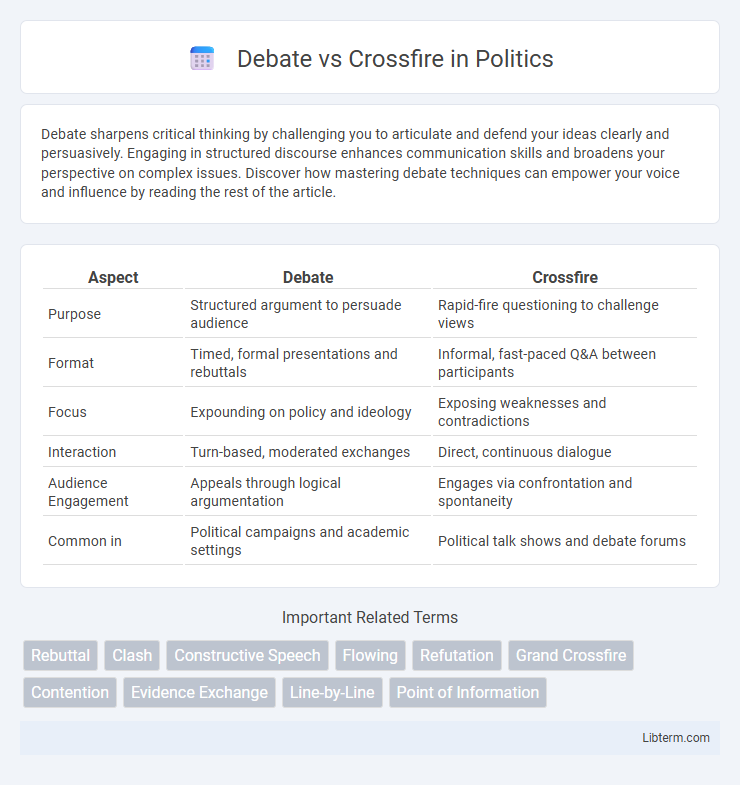Debate sharpens critical thinking by challenging you to articulate and defend your ideas clearly and persuasively. Engaging in structured discourse enhances communication skills and broadens your perspective on complex issues. Discover how mastering debate techniques can empower your voice and influence by reading the rest of the article.
Table of Comparison
| Aspect | Debate | Crossfire |
|---|---|---|
| Purpose | Structured argument to persuade audience | Rapid-fire questioning to challenge views |
| Format | Timed, formal presentations and rebuttals | Informal, fast-paced Q&A between participants |
| Focus | Expounding on policy and ideology | Exposing weaknesses and contradictions |
| Interaction | Turn-based, moderated exchanges | Direct, continuous dialogue |
| Audience Engagement | Appeals through logical argumentation | Engages via confrontation and spontaneity |
| Common in | Political campaigns and academic settings | Political talk shows and debate forums |
Understanding Debate: Structure and Purpose
Debate involves a structured format where participants present arguments on a specific resolution with clear phases for constructive speeches, rebuttals, and closing statements designed to persuade judges or audiences. Its purpose centers on critical thinking, effective communication, and the logical evaluation of opposing viewpoints to reach a reasoned conclusion. Understanding this structure enhances strategic preparation and the ability to anticipate counterarguments, distinguishing debate from the more spontaneous and rapid-fire exchange found in crossfire.
What is Crossfire: Definition and Format
Crossfire is a fast-paced debate format centered on direct, spontaneous exchanges between participants, designed to highlight quick thinking and sharp argumentation. The format involves participants asking and answering pointed questions in a timed session, promoting clarity and the immediate defense or rebuttal of ideas. This interactive approach contrasts with traditional debate structures by emphasizing real-time dialogue over prepared speeches.
Core Differences Between Debate and Crossfire
Debate centers on structured argumentation with teams presenting formal cases and rebuttals, emphasizing evidence and logical reasoning. Crossfire prioritizes rapid, interactive questioning between participants to challenge assertions and clarify positions in real time. The core difference lies in debate's organized, formal format versus crossfire's dynamic, spontaneous exchange.
Rules and Etiquette in Debate
Debate follows structured rules with timed speeches, specific formats like Lincoln-Douglas or Policy, and strict adjudication criteria focused on argument clarity and evidence, emphasizing respectful engagement and civility among participants. Crossfire sessions, integrated within debates, encourage quick back-and-forth questioning but maintain decorum by prohibiting personal attacks, interruptions, and disruptions to ensure a focused and fair exchange of ideas. Adhering to these rules and etiquette fosters an environment where logical reasoning and persuasive communication are prioritized over confrontation or hostility.
Crossfire Techniques: Strategies for Success
Crossfire techniques in debate emphasize rapid questioning and quick rebuttals, forcing opponents to think on their feet and manage pressure effectively. Mastering effective listening, concise argumentation, and strategic questioning enhances crossfire success by exploiting opponents' weaknesses and clarifying key points. Utilizing simultaneous engagement and maintaining clear, logical responses are pivotal strategies that differentiate skilled crossfire participants.
Skills Developed in Traditional Debate
Traditional debate sharpens critical thinking by requiring participants to construct logical arguments and anticipate counterarguments effectively. It enhances public speaking skills, promoting clarity, persuasion, and controlled delivery under pressure. Participants also develop research proficiency and the ability to analyze complex topics quickly to support their positions convincingly.
The Importance of Questioning in Crossfire
Crossfire emphasizes the critical role of questioning to challenge assumptions and clarify opponents' arguments, promoting deeper understanding and engagement. Unlike traditional debates that follow structured speeches, Crossfire's rapid-fire questioning exposes weaknesses and tests evidence with real-time interaction. This dynamic exchange sharpens critical thinking skills and encourages participants to think on their feet, making questioning fundamental to Crossfire's effectiveness.
Choosing Between Debate and Crossfire: Factors to Consider
Choosing between Debate and Crossfire formats depends on factors such as the desired level of interaction, time constraints, and the educational objectives. Debate emphasizes structured arguments and formal rebuttals, ideal for developing critical thinking and public speaking skills. Crossfire encourages dynamic exchanges and spontaneous questioning, fostering quick thinking and adaptability in participants.
Common Misconceptions about Debate and Crossfire
Debate and Crossfire are often confused, but they have distinct formats; Debate typically involves structured arguments with formal speeches, while Crossfire centers on rapid-fire questioning and direct interaction between participants. A common misconception is that Crossfire is less formal, but it actually demands quick critical thinking and effective rebuttals under time pressure. Both formats require strong analytical skills and clear communication, but their strategies and pacing differ significantly.
Enhancing Critical Thinking: Debate vs Crossfire
Debate structures promote critical thinking by requiring participants to research, formulate arguments, and anticipate counterarguments while maintaining organized presentation. Crossfire sessions intensify critical analysis as participants engage in rapid, direct questioning and real-time rebuttals, honing quick reasoning and adaptability. Both formats enhance cognitive skills, but debate emphasizes evidence-based argument construction, whereas crossfire sharpens spontaneous critical thinking within dynamic exchanges.
Debate Infographic

 libterm.com
libterm.com